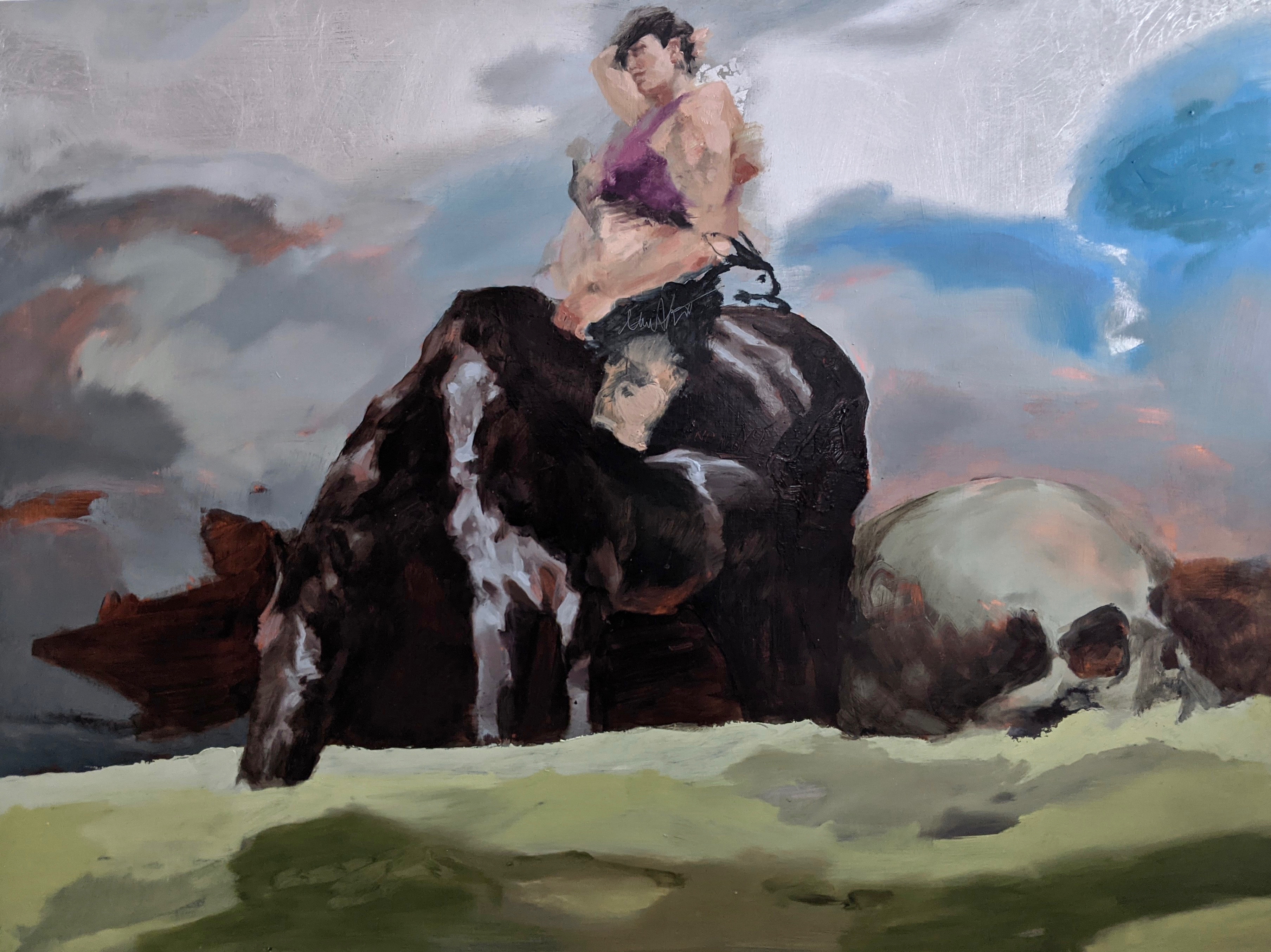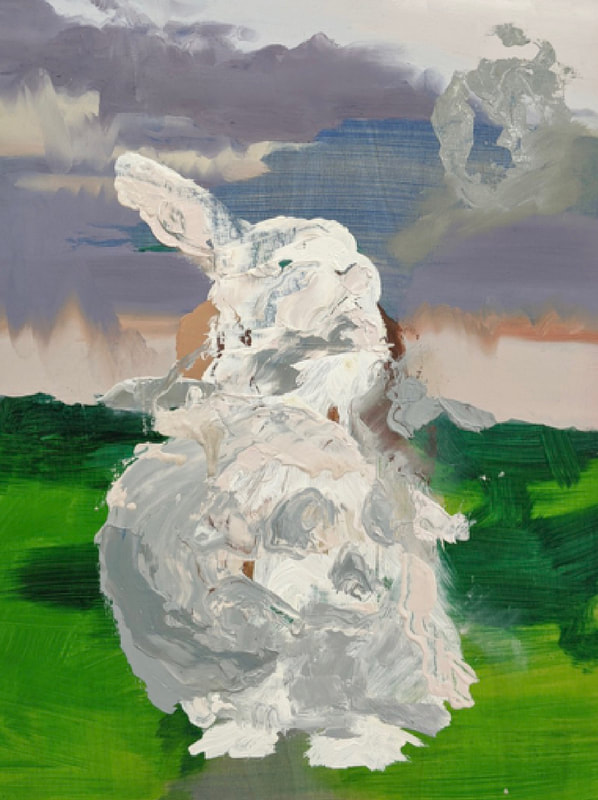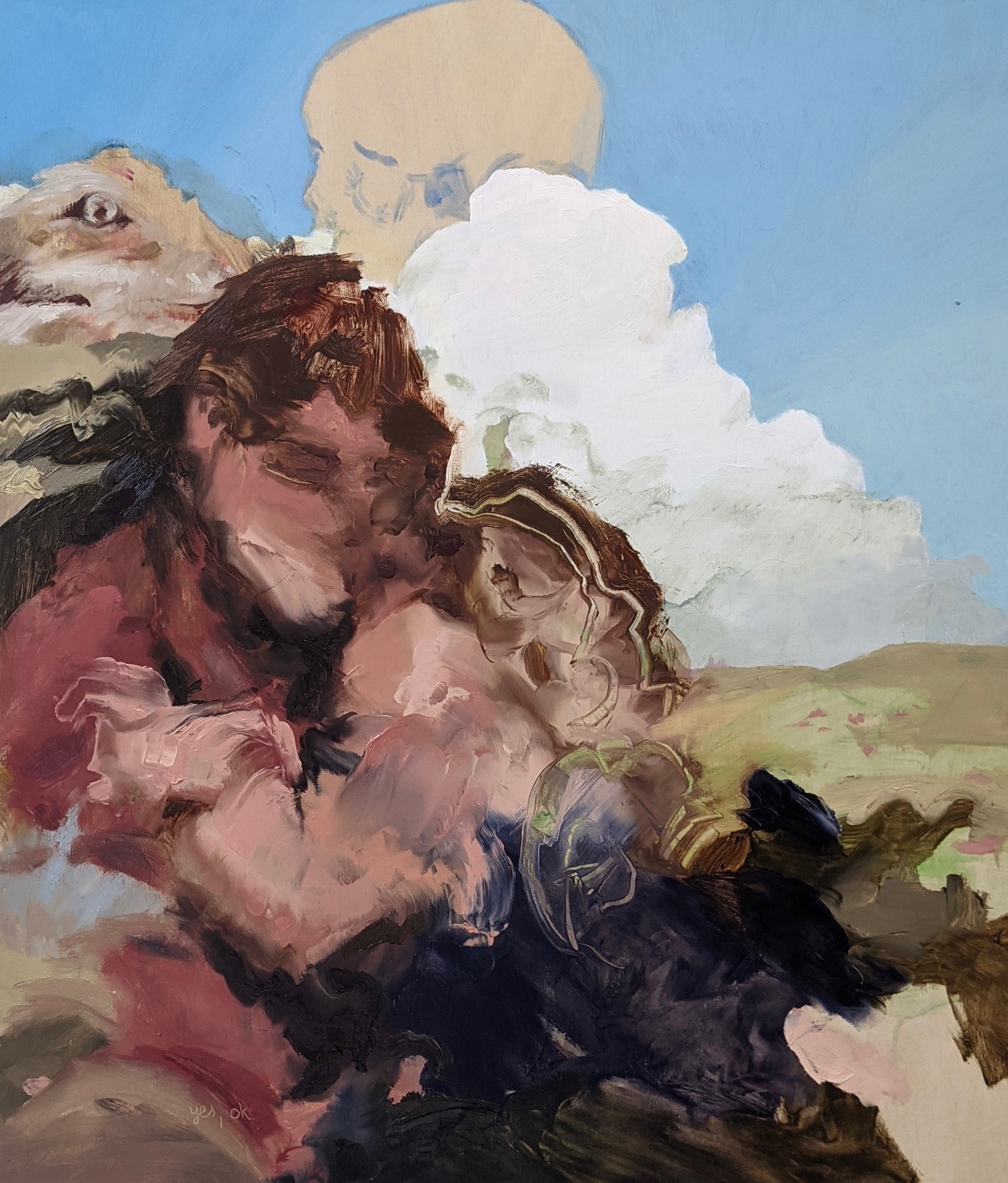IN CONVERSATION WITH:
MARION ABRAHAM
MARION ABRAHAM
(05.10.21)






In Conversation with Sophie Spence
Sophie Spence: I’ve looked at your work and been kind of mystified by it. I truly feel it has this mythical quality that I’m really engaged by, but I can also see myself or these modern figures in these biblical settings, which I find really interesting. I wanted to get a sense for what informs your classical style and where that amalgamation comes from.
SS: It’s very interesting. I don’t know how long these works take you, but I was also thinking when I’m making work I get very distracted, very easily, so it’s a totally different process. How does it feel to sit with something for such a long time, or to really refine one work?
SS: Look what I did, with these hands! (laughs)
SS: How do you choose your subject matter? If you need to connect with these characters, how do you choose what to depict?
SS: One of your works is a person sitting on a horse in a bra. Something about that image to me is really interesting. Because the painting itself, it’s very consistent with that classical style. But something about the bra really takes me, and reminds me of myself and my experience. And that feminist aspect you’re talking about draws me back into my world. So I consider what are the parallels? Then I’m questioning the parallels between the modern woman and this experience from the past, these tensions you’re dealing with are really interesting.
SS: When you’re approaching that intimacy, that discussion around intimacy with your subjects is really interesting. I'm used to photographing people and we have that discussion around the gaze and what it means to photograph a person and the power you are enacting by taking that photo, how do you feel about that? Are these characters people you know or are you inventing this kind of fantasy land? And how do you approach that intimacy?
SS: Is there an emotion that you connect with that you lean toward normally when you’re going through these character emotions? What do you lean toward?
SS: Yeah absolutely, you’re in this space and invited to enter into this space when you’re looking. It’s almost a tool for self engagement because you’re having this dialogue with this painting, really interesting.
SS: The animals, how do you choose them, what is the place of them? It feels to me that they are a signifier of classical painting style, but is there anything else to it for you?
SS: I really love these ideas, with a sheep and a woman. It’s a kind of an intimate moment. I love these dialogues between person and animal, these connections. It brings an intimacy and warmth to the paintings. It's a special addition.
︎
Marion is a Melbourne based artist. She has a deep love for the sculptural capacity of paint combined with story-heavy imagery. Marion's practice is an extension of her experience in the natural world. Her work carries the signifiers of bygone eras and old lands. Traditional power structures and gender roles are reimagined in Marion's work: she loves the humorous, the violent and the beautiful.
To see more work by Marion Abraham, visit - Website / Instagram
︎
Marion Abraham: Yeah, I think I often ask myself that too. You always wonder, why are you drawn to something repeatedly? Over and over again. I’m often asking myself, is it because I like it or because that’s how I’m trained to understand this medium. I went through a bit of a like... kind of self taught but via the classics. Then a little bit of study, classical style teaching, anatomical and colour tone kind of stuff. I was just really interested in the mechanics of painting. I found that pretty mysterious. I was like how do you do this? What a mystery, how fascinating. And so I think studying the history of the Western canon of painting and then figuring out how to do it yourself, it all kind of stays in you. And lately - I’m in my third year now [of university] - I’m trying to figure out how I’ve digested all that information and what’s coming out now and yeah, I don’t know. I think a lot of the reasons I really like painting are because of its treatment. How it treats its subject and how you can spend time with a subject, and you know you really have to work around forms and fall in love with characters and landscapes and sky. You spend so much time with it all. Mixing the colours, mixing the components of something to bring it into being.
SS: It’s very interesting. I don’t know how long these works take you, but I was also thinking when I’m making work I get very distracted, very easily, so it’s a totally different process. How does it feel to sit with something for such a long time, or to really refine one work?
MA: I try to work reasonably quickly, but I spend a lot of time preparing. And I think I’ve hit the sweet spot where I’ve spent a lot of time mixing colours and thinking about the composition of something. Like hours and hours. I like to paint and then I might come back within that day or within the next day with a whole new energy and really go into that image quite quickly. Even paint constantly, for hours. That feels really good to me these days. I'm quite an impatient person so I try to harness that. I really like sitting with a piece of work after it’s made. Especially something quick, and it works, then you sit with it. That’s a very interesting time after the painting. And I paint over a lot of stuff. But when it works you’re like, ‘shit look at this, that’s been created out of nothing, that’s a miracle.’ (laughs)
SS: Look what I did, with these hands! (laughs)
MA: That sounds sort of silly doesn’t it. I guess you’ve got to find your medium entertaining. Or why would you do it? I still find painting pretty entertaining. I can’t believe pigments in 2D can make something 3D, that still entertains me.
SS: How do you choose your subject matter? If you need to connect with these characters, how do you choose what to depict?
MA: I think there's a lot of fantasy in the way I use things, or like an idealisation. I think a lot of it is a reaction to the history that I learned and the imagery that I was brought up in the art world with, more historically than in a contemporary setting I guess.
I’m really drawn to ideas around strength. Also that adage of painting what you want to see - some of that comes into it. And then it’s funny being in art because you also want to make work that is somewhat deeply personal as well. So finding the middle zone of those things is a really interesting challenge and I think it’s a nice spot in my career. Just at the end of third year and looking to do an honours year, where I’m starting to feel more confident about making work. But I often ask myself, why don’t you make work about your own life? Your actual life. Why don’t you photograph yourself, or paint yourself? But literally this morning, I thought why aren’t you making that work? Obviously I don’t want to. So in the meantime I'm back in fantasy land.
SS: One of your works is a person sitting on a horse in a bra. Something about that image to me is really interesting. Because the painting itself, it’s very consistent with that classical style. But something about the bra really takes me, and reminds me of myself and my experience. And that feminist aspect you’re talking about draws me back into my world. So I consider what are the parallels? Then I’m questioning the parallels between the modern woman and this experience from the past, these tensions you’re dealing with are really interesting.
MA: It’s funny the things your eye might settle on, and clothing is such a huge one in painting. Your treatment of light and your treatment of clothing. People haven’t really changed that much, but both those two things have changed a lot. Throughout periods of art history, the way painters went about portraying light on a subject really places their work in centuries. Which is again amazing. And I guess clothing as well, you know if you paint clothes on someone you land them at a place in history, you really do. At first, from a classical background I said I’ll just paint everyone naked, this is just too much of a commitment. But then I was like ‘fucks sake Marion’, that’s ridiculous. I also have a huge problem with gaze and talking about objectification, and how to control and afflict that and think about that. You have to think about that stuff. You have to have a reply to some extent when you work. That’s a part of the challenge and you know I’m wild for a sports bra. I always feel incredible in a well-fitting sports bra, I’m bomb proof.
SS: When you’re approaching that intimacy, that discussion around intimacy with your subjects is really interesting. I'm used to photographing people and we have that discussion around the gaze and what it means to photograph a person and the power you are enacting by taking that photo, how do you feel about that? Are these characters people you know or are you inventing this kind of fantasy land? And how do you approach that intimacy?
MA: It’s just the tricky nature of having people in your work no matter what your medium is. I looked at other artists a lot to see how they manage that relationship. From painters like Alice Neil, who had a career doing the most intimate portrait painting, but in the most amazing free modern way; but it was always about the relationship. They were always in the room together. Then you go to someone else who I love like Claire Tabouret, a french painter who uses photos from the past that she finds. As well painters like Chloe Wise, who uses photos of her friends. I think about that and how they use photography, and I feel like I sit somewhere in between all of that. There’s something in found images, taking anatomy or poses from them because there’s a universality that is really exciting to connect with and manipulate. I guess I’m quite interested in those things, those signals of emotions, and that’s where I’m playing at the moment. But that doesn’t mean I wouldn’t like to paint more personally. It’s just not something I’ve really started with and I think there’ll be a time maybe where it’ll be a nice natural jump.
SS: Is there an emotion that you connect with that you lean toward normally when you’re going through these character emotions? What do you lean toward?
MA: I think I really like subjects that are very present, they’re almost looking or have a gravity of seeing just behind an audience's shoulder. Just beyond but very engaged. I don’t have many subjects that aren’t looking out, I like people looking out from paintings with a pinch of remoteness. It allows you access to come in as a viewer which is nice. One of my favourite paintings which I kept, I did it ages ago and it was in a small show of works. I was like eh this painting is ridiculous, but I kept it. I have it in my lounge room above my couch and it has stayed there ever since. Every night I look at it, I hang out with this person every single night on the couch. I really like having it there, living with it. It reminds me how painting can be an emotional escape.
SS: Yeah absolutely, you’re in this space and invited to enter into this space when you’re looking. It’s almost a tool for self engagement because you’re having this dialogue with this painting, really interesting.
MA: In a way, all mediums have this unique way of doing that. TV is one form of escapism, reading a book is one, podcasts are one, paintings are their own one as well. More and more, I’m enjoying thinking deeply about painting. Rather than thinking I might do some other things or whatever.
SS: The animals, how do you choose them, what is the place of them? It feels to me that they are a signifier of classical painting style, but is there anything else to it for you?
MA: Good question. Well they’re delightful to paint full stop. They’re so fun and cute and I always find it pretty interesting thinking about the consciousness of anything else that’s not human. It’s a reminder of the connection between things. Then when you paint an animal, you also get to add an anthropomorphisation to that subject. Relating it to that human subject, it’s something fun to do I think. Each picture is so different in how that manifests, specifically to a different goal. Each different picture.
SS: I really love these ideas, with a sheep and a woman. It’s a kind of an intimate moment. I love these dialogues between person and animal, these connections. It brings an intimacy and warmth to the paintings. It's a special addition.
MA: I think there’s a lot of caring. Which is another subject that I really love and wouldn’t really do explicitly - and deep care between things is such a nice element to pictures.
︎
Marion is a Melbourne based artist. She has a deep love for the sculptural capacity of paint combined with story-heavy imagery. Marion's practice is an extension of her experience in the natural world. Her work carries the signifiers of bygone eras and old lands. Traditional power structures and gender roles are reimagined in Marion's work: she loves the humorous, the violent and the beautiful.
To see more work by Marion Abraham, visit - Website / Instagram
︎